|
Temporarily Under Construction
Franks Casket: The Stomping Ground of Romano Germanic Gods
About 7 Deities, the 7 Days of the week, the 4 Seasons and the 12 Months of the year
Or: Another gear-wheel to an - as so far undetected - early medieval astronomic clockwork.
Alfred Becker, Liþa 2015; To Stephen Pollington and the Elder Gods with respect and gratitude
The Panels and Lid
Because of just one picture with Christian background the Franks Casket has been regarded an object of religious purpose, a reliquary or a portable altar, for example . Strangely enough, none of the runic inscriptions refers to Christian religion, in what way ever. Nevertheless, more recent interpretations claim the carvings for an obscure biblical tradition, though – apart from the picture of the child adoring Magi – there is no clue, neither in the runic text nor in the pictures, for such an interpretation. As a matter of fact the Christian mission would demonise pagan ideas and means while the old creed readily adopted anything that was believed to be helpful, last but not least the bounteous Magi. Looking more closely at their picture, even this single image with a biblical background, is only ostensibly Christian.
The neighbouring carving depicts Wayland / Völund, “lord of the elves”, as King Nidud / Niðad refers to the mythical smith . With him a scene from the pagan Germanic mythology is presented here.
Romulus and Remus (here: Romwalus and Reumwalus) on the left panel refer to Roman mythology, though the scenery (Woden’s two wolves along with warriors adoring the twins in a sacred grove) and even their names (wal, carnage, slaughter) have been adjusted to the martial pagan purpose, i.e. help on the ride to war.
Titus conquering Jerusalem as rendered on the back of the chest is a topic from classic Roman history, slightly adjusted to the carver’s intent by placing the beasts of the Æsir beneath the arch. This Roman triumph is meant to provide victory and fame.
Herh-Os, a Deity or Valkyrie of the grove, bringing death over some chosen hero, is the topic of the right panel. She will take her victim to Valhalla. There (on the lid) we meet an archer, Ægili, defending the fortress against the giants, thus referring to the essence of pagan creed. The intention of these two panels refers to death and afterlife. Actually, battlefield (right panel) and Valhalla (lid) adjoin here.
This way the sequence of carvings procures an ideal course of heroic life and the hereafter.
Looking at the runic texts we detect a number of regularities, very much beyond mere chance.
So the contents of all these pictures correspond directly or indirectly with the meaning of the first rune in the upper left corner, where it is the first letter in a name (e.g. Titus) or name-like term (e.g. fisc). As there are two pictures on the front the second letter in alliteration is the initial of the kenning gasric; and as the lid only knows the titulus Ægili, this initial serves the same purpose.
The total value of these 6 runes       (F G R T S Æ) results in 72 (9x8 or 3x24) a score frequently observed on the casket and elsewhere. (F G R T S Æ) results in 72 (9x8 or 3x24) a score frequently observed on the casket and elsewhere.
These functional runes follow a 9-rune formula on the left border of three panels (front, left, and back); on the remaining panel (right) the 9-rune formula is placed on the right edge, where it precedes a well-wishing set of runes. The numeric values of these formulas aim at the multiple of 11. Elsewhere runes and values follow the significant number 24 (number of runes in the fuþark, total value 300) and its multiple, 72 in particular. Eventually the overall numbers and values form a solar and a lunar calendar system, balanced by a Metonic cycle hidden in the Latin text on the back panel.
To sum it all up, the chest is likely to have been the hoard box of some Anglo-Saxon king, the pagan Penda of Mercia († 655) or Edwin of Northumbria († 633), maybe, who grew up as a pagan and eventually gave in to his wife and, possibly, to papal urging along with political considerations. He may have kept the casket on his lap when banqueting in the hall, honouring his warriors with golden trinkets out of it, Feohgift   , as he might have said. , as he might have said.
It may seem surprising that the pagan nature of the casket had not become apparent. Christian zealots often destroyed the meagre written tradition or – at best – adjusted it to their own religious views as they did with the “Runic Poem”, where among others the name os (god) for the o-rune o was replaced by the Latin meaning of os, “mouth”, while the god Tiw behind  was replaced by Tir, "glory". Only the Icelandic tradition saved some of its heritage from purgatory, and had it written down in this or that Christian scriptorium of the 13th century. Thus there is a gap of 500 years between our magic box and those sources. was replaced by Tir, "glory". Only the Icelandic tradition saved some of its heritage from purgatory, and had it written down in this or that Christian scriptorium of the 13th century. Thus there is a gap of 500 years between our magic box and those sources.
The other approach leads back to Roman tradition where – according to the Interpretatio Romana – the northern gods went by the names of their Roman counterparts. As for Sol and Luna this does not cause a problem, but if the gods were defined by their attributes identification may become uncertain. With a time gap of 700 years back to Roman days and 500 years up to Iceland’s scribes we have 1200 years of uncertain tradition, which makes a synopsis intricate.
The two antique sources we refer to are the notes by Julius Caesar and – a bit more detailed – by Tacitus. Caesar writes: “The Germans … rank in the number of the gods those alone whom they behold, and by whose instrumentality they are obviously benefited, namely, Sol, Vulcanus and Luna. They have not heard of the other deities even by report.” It is unlikely, though, that Caesar should not have heard of any other Germanic Gods.
About one hundred years later, Tacitus refers to another trinity in which “Mercury is the most venerated God, who at certain times even receives human sacrifice while Hercules and Mars are consoled with a sacrificial animal.” In this constellation Mercury stands for Woden / Odin while Hercules typifies Þunor / Thor and, finally, Mars epitomises Tiw / Tyr. Tacitus does not mention Freyr, who rules over sunshine, rain and plant-life and who along with his golden boar Gullinborsti is seen as sun-god.
If the runic casket is inspired by pagan views we should be able to detect traces of the one or the other trinity, if not of both of them. For this approach we relate to the front panel first and then we continue the research around the chest in a clockwise direction.
The Front Panel (F – G): Sol, Luna and Vulcanus
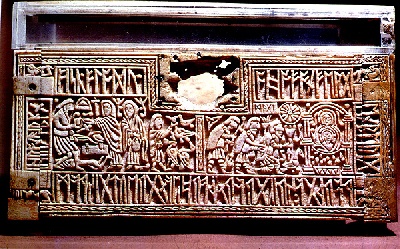
© Trustees of the British Museum
As we have already shown the picture of the Magi is a pagan adoption of a Christian motif.
Most striking is the bird instead of the guiding (or guarding) angel. If pagan it is the child’s Fylgja, who appears to living people in her bird shape. The rosette would stand for the star of Bethlehem, but with its 13 rays it rather refers to a lunar calendar (13 m. x 28 d. = 364 d/y.) The third of the Magi, finally – he who brings myrrh, which is used for embalming dead bodies – is distinguished by a valknut, Woden’s hallmark of death. Of similar significance is the eoh-rune  m meaning "year" (number 12 in the runic row; number 13 if read from the end to there) standing for the poisonous yew tree. It may be understood as a symbol of the endless cycle of life, death and resurrection, of waxing and waning. Several such seemingly ornamental marks are filled into this picture, among others 13 dot-marks filling the lower part of the throne, which reflect 13 lunar months under the rule of the moon as we shall see below.
Wherever else on the casket m meaning "year" (number 12 in the runic row; number 13 if read from the end to there) standing for the poisonous yew tree. It may be understood as a symbol of the endless cycle of life, death and resurrection, of waxing and waning. Several such seemingly ornamental marks are filled into this picture, among others 13 dot-marks filling the lower part of the throne, which reflect 13 lunar months under the rule of the moon as we shall see below.
Wherever else on the casket  appears (Right and Lid) it is used in the same context. appears (Right and Lid) it is used in the same context.
Different from all other presentations of this topic (Magi) is the group of mother and child. 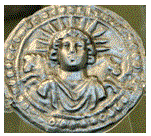 Instead of the Virgin sitting on a throne, holding the child on her lap and he greeting the visitors, there are only their disc-like faces, marked by halos – that of the child cross-shaped. This presentation is similar to that of Sol Invictus ("Unconquered Sun"), who was the official Sun-god of the later Roman Empire and a patron of soldiers. Instead of the Virgin sitting on a throne, holding the child on her lap and he greeting the visitors, there are only their disc-like faces, marked by halos – that of the child cross-shaped. This presentation is similar to that of Sol Invictus ("Unconquered Sun"), who was the official Sun-god of the later Roman Empire and a patron of soldiers.
This idea may have been inspired by the cult of Mithras, who also went by this title, a title which was soon adopted by the new Christian religion along with the Dies Natalis Solis Invicti, the 25th of December, i.e. the birthday of the “Invincible Sun”. Thus Sunday is observed as a day of worship and rest, holding it as the Lord's Day, the day of Christ's resurrection. Along with this the Virgin was identified with Luna, who mirrors her faith in Christ like the moon reflects sunshine.
Many pictures show her with the crescent of the moon under her feet. 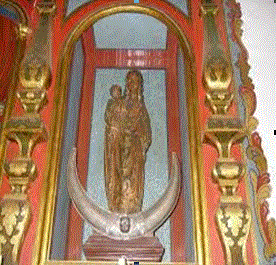 Finally Pope Innocent III (around 1200) allowed the association of Mary and Moon: "Anybody buried in the shade of sin should look up to the moon. After having lost the grace of God, there will be no day, no sun to shine on him, but there is still the moon above the horizon. Let her talk to Mary under whose guidance many find the right way to God." Finally Pope Innocent III (around 1200) allowed the association of Mary and Moon: "Anybody buried in the shade of sin should look up to the moon. After having lost the grace of God, there will be no day, no sun to shine on him, but there is still the moon above the horizon. Let her talk to Mary under whose guidance many find the right way to God."
Sun and Moon along with Earth Mother (mother and child) will have played a mayor part in early pagan creed; anyway, due to lack of written tradition our knowledge is poor. Referring to our picture we may say that Christ’s face stands for Sol, while the face of Mary symbolizes Luna. As such they are venerated by the Magi, who will have been seen by Mathew as priests of Mitra. Now, as with Sol and Luna we have detected two of the three gods Caesar mentions we need to look for Vulcanus, the god of fire and smithery.
And here the picture of Wayland comes in. He is a skilful smith, just like his Roman counterpart, and like him he limps, though for different reason. Wayland originally (Völundarkviða) belonged to the elfish sphere of lower mythology . Nevertheless, his saga is not clearly based on a Roman or Greek archetype, but the maltreatment of children may be the common denominator as discussed below.
With Sol / Christ and Luna / Mary, venerated by the Magi, and Vulcanus / Wayland at his anvil, the carver has rendered the trinity Caesar mentions in his “De Bello Gallico”. This may answer the frequently discussed question why the carver has placed two such contradictory motifs, the “Adoration of Christ” and “Wayland’s Revenge”, side by side. As we have seen he had more than one reason for his choice:
1. With the goldsmith forging valuables (feoh, wealth) there is a motif to go with the rune  . And with the Magi bringing presents (gifu, gift) we have got the motif for the rune . And with the Magi bringing presents (gifu, gift) we have got the motif for the rune  . .
On the one hand these runes, supported by their number and value, help the incantation expressed by the motifs, on the other hand feoh and gifu describe the content of the royal chest as feohgift, meaning ‘bounty’, to be handed out with ‘largesse’ by the chief, sitting on his giefstol in the hall.
2. The motif of the new born King serves very well as a family background for the royal owner of the chest. The inclination to derive one’s pedigree from the Æsir changed over to Christ and the Holy Family. The Fylgja, depicted here in her bird-nature, links this motif with that of Wayland, where she proves her protective powers by helping her protégé to win over his oppressor.
3. Elevating this chosen assembly into the rank of the trinity Sun, Moon and Fire (or as Caesar interprets: Sol, Luna and Vulcanus) increases the power of the charms and establishes a new quality in the context of the remaining panels and lid as shown below.
The Left Panel ( R ): Hercules
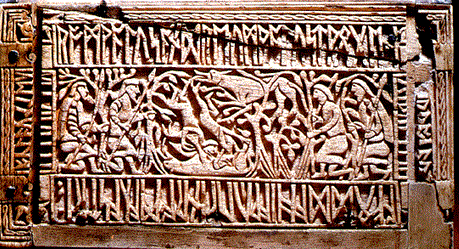
© Trustees of the British Museum
The picture of the Roman twins differs from all the others we know. 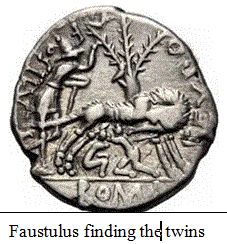 Either the twins are depicted all alone with the she-wolf or – rather seldom in the ancient world – their retrieval by the shepherd is rendered, but there is no piece known that would show them adored by a gang of armed warriors somewhere in a grove. The roots there seem to function as “tree runes” foretelling the fortune of the warriors and the fate the twins bring about. Ancient pictures would place the baby-brothers under the she-wolf where they are fed, but none would show them as youngsters. Moreover, we have Woden’s two wolves instead of just the lone lupa.
Either the twins are depicted all alone with the she-wolf or – rather seldom in the ancient world – their retrieval by the shepherd is rendered, but there is no piece known that would show them adored by a gang of armed warriors somewhere in a grove. The roots there seem to function as “tree runes” foretelling the fortune of the warriors and the fate the twins bring about. Ancient pictures would place the baby-brothers under the she-wolf where they are fed, but none would show them as youngsters. Moreover, we have Woden’s two wolves instead of just the lone lupa.
These attributes prove our carving to be an Interpretatio Germanica of the traditional Roman motif. By changing their names to Romwalus and Reumwalus they adopt the same martial nature as the Valkyrie, the chooser of those heroes who have to die at war and those who may live.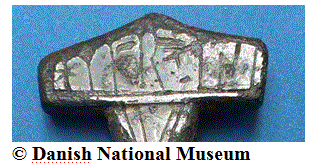 Anyway, it would have been closer to home if the rune master had picked other war helping twin brothers like the legendary Hengist and Horsa, but their names begin with Anyway, it would have been closer to home if the rune master had picked other war helping twin brothers like the legendary Hengist and Horsa, but their names begin with  , a rune auguring ill fate. The initials of the Roman twins, however, provide the proper rune, as according to the “Runic Poem” , a rune auguring ill fate. The initials of the Roman twins, however, provide the proper rune, as according to the “Runic Poem”  means rad, NE “ride”, be it on horseback or on a cart, as in OE. Þunorrad (thunderclap), which refers to Thunor’s / Thor’s thundering ride in his armed chariot through the clouds. means rad, NE “ride”, be it on horseback or on a cart, as in OE. Þunorrad (thunderclap), which refers to Thunor’s / Thor’s thundering ride in his armed chariot through the clouds.
Another object, the Lolland Runic Thor's Hammer, also indicates that the rune  is associated with Thor as the inscription violates simple orthography by omitting and filling in signs in order to push the rune is associated with Thor as the inscription violates simple orthography by omitting and filling in signs in order to push the rune  into the centre of the hammer head along with the proper runic value. The owner may have hoped to increase the power of his pendant by connecting the flash of Thor’s hammer with the thunder of his rune. into the centre of the hammer head along with the proper runic value. The owner may have hoped to increase the power of his pendant by connecting the flash of Thor’s hammer with the thunder of his rune.
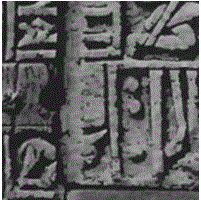 The text, framing the picture ends (bottom left corner) with 3 dot-marks. As we ascribe numeric value to such marks they refer to the third rune of the fuþorc, according to the “Runic Poem” ðorn (NE. thorn), which is quite likely the substitute for the pagan Þunor (Donar, Thor). This way the spell (text) based on The text, framing the picture ends (bottom left corner) with 3 dot-marks. As we ascribe numeric value to such marks they refer to the third rune of the fuþorc, according to the “Runic Poem” ðorn (NE. thorn), which is quite likely the substitute for the pagan Þunor (Donar, Thor). This way the spell (text) based on  is framed by the introductory 9-rune formula oþlæ unneg and the final invocation of Þunor/Thor, the god “in charge”. He is the counterpart of Hercules in Tacitus’ trinity. And Hercules, again, is sometimes regarded to be their father, though mostly Mars is held resposible. is framed by the introductory 9-rune formula oþlæ unneg and the final invocation of Þunor/Thor, the god “in charge”. He is the counterpart of Hercules in Tacitus’ trinity. And Hercules, again, is sometimes regarded to be their father, though mostly Mars is held resposible.
The Back (T): Mars
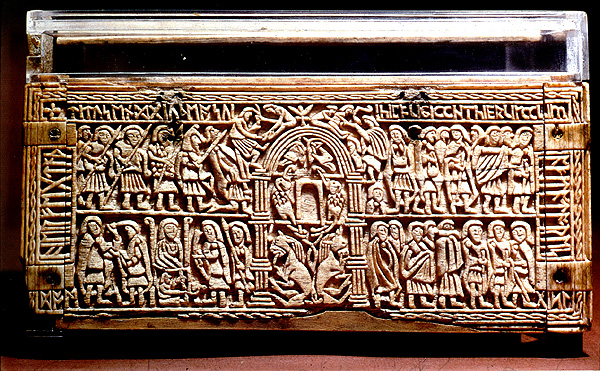
© Trustees of the British Museum
The picture of Titus conquering Jerusalem is without any direct antique parallels though the arrangement on two horizontal levels vertically divided by an arch could be adopted from some ancient sarcophagus. The upper level shows the Roman victory and the escape of the Jews. The lower section, left, presents a court scene titled doom, while the right section renders the decampment of hostages, as the word gisl tells us.
So far the picture seems to follow a Roman pattern; only the three pairs of animals, horses (?), wolves (?) and raven (?) may be understood as the companions of the Germanic gods. The bird heads, linked by a valknut , point to Woden / Odin; the horses might belong to Tiw / Tyr; the creatures between top and bottom would then go with Thor, though nothing would give them away as goats. Else, they simply are beasts of battle.
Apart from the animals and three interlaced knots there is a plant-like symbol on top of the arch, looking very much like the icon  of the Valkyrie (Front, Wayland). Her hallmark (much like a bird’s footprints) helps, at least, to guess the realm to which these creatures belong. of the Valkyrie (Front, Wayland). Her hallmark (much like a bird’s footprints) helps, at least, to guess the realm to which these creatures belong.
Intended or not, there are 24 horizontal segments dividing construction of the arch.
Here again we find a 9-rune formula, her/fegtaþ, on the left edge, followed on the upper edge by the rune  , the first letter forming the name Titus. The name of the rune is Tir, which hints at the old god Tiw / Tyr, who stood for heroic glory and justice. And quite precisely, this is what the panel is about. , the first letter forming the name Titus. The name of the rune is Tir, which hints at the old god Tiw / Tyr, who stood for heroic glory and justice. And quite precisely, this is what the panel is about.
Glory by victory and justice is the highest aim in the life of our royal hero, gifts granted by Tiw / Tyr, who corresponds with the Roman god of war and the father-god of Rome, Mars.
Note: With the phrase H CFUG CFUG ANTH ANTH E E U U AL AL M the rune-master uses the language (Latin) and letters (majuscules), normally reserved for clerical purposes, for a trivial and fragmented comment. This shows that he had the means to deliver a religious message – if he had intended this – in the proper way. As to here, he used letters and language to create a Metonic cycle. M the rune-master uses the language (Latin) and letters (majuscules), normally reserved for clerical purposes, for a trivial and fragmented comment. This shows that he had the means to deliver a religious message – if he had intended this – in the proper way. As to here, he used letters and language to create a Metonic cycle.
The Right Panel (H – S): Mercurius
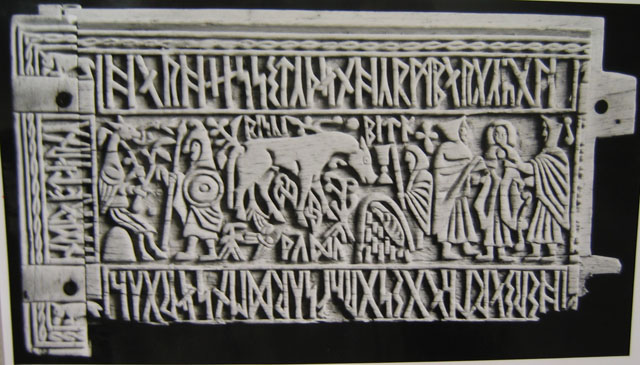
Photo courtesy Bargello Museum, Florence
The picture as a whole is without any parallel, neither in classical art nor in domestic pagan tradition. It is structured in three emblematic (i.e. non-dramatic) scenes, which correspond to the three staff rhyme verses of the runic text on this panel. Their background is altogether pagan. The text itself is kept cryptographic, replacing the vowels by marks similar to runes, so that the ill fate, death, may not come about before due time.
Left: 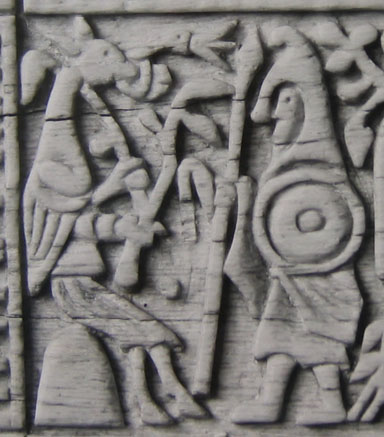 Herh-Os seems to be the name of the creature sitting here on a mound (harmberg), a Valkyrie most likely. Herh (hearg) means the pagan holy grove; Os identifies the creature dwelling there as a deity. The shape of her head may be that of a cow elk, a species (elk) that is reflected in the rune Herh-Os seems to be the name of the creature sitting here on a mound (harmberg), a Valkyrie most likely. Herh (hearg) means the pagan holy grove; Os identifies the creature dwelling there as a deity. The shape of her head may be that of a cow elk, a species (elk) that is reflected in the rune  elk sedge (O.E. eolhx), which seems to typify Valkyries and their bellicose power. elk sedge (O.E. eolhx), which seems to typify Valkyries and their bellicose power.
The snake around her head stands for her deadly duty, choosing the heroes for Valhalla. As it lives beneath the earth in the dark it is a symbol of death, and as it can shed the snake is a symbol for rebirth. It is a symbol for Odin as well, as he used to change into that shape and so it is he who speaks through that Valkyrie to that warrior.
The wings refer to the bird-shape she can adopt anytime and the skirt is part of her human appearance. Also her anatomy (joints), when sitting, is that of a human being.
The twig in her hands may be a lot-twig telling the hero’s fate. The titulus risci seems to comment on it, though, more likely, it has to be understood in context with the other two tituli.
Centre: The victim lies in his grave; the 11 fillers inside may refer to the rune  (is, ice) which is synonymous with “death”. There his Valkyrie, now in her human shape, comes to him, in order to restore him with a revitalizing drink - alu , maybe - from the chalice. She holds a rod which – ending in the rune (is, ice) which is synonymous with “death”. There his Valkyrie, now in her human shape, comes to him, in order to restore him with a revitalizing drink - alu , maybe - from the chalice. She holds a rod which – ending in the rune  in bita – turns into a spear. The horse, marked by two valknutr (Woden/Odin’s symbol) will carry the hero to Valhalla, the hall of the slain. This scene reminds us of the Scandinavian standing stones like Lärbro Tängelgårda, which show the triumphant arrival of the warriors and their welcome by the Einherjers at Odin’s place in Asgard. in bita – turns into a spear. The horse, marked by two valknutr (Woden/Odin’s symbol) will carry the hero to Valhalla, the hall of the slain. This scene reminds us of the Scandinavian standing stones like Lärbro Tängelgårda, which show the triumphant arrival of the warriors and their welcome by the Einherjers at Odin’s place in Asgard.
Right: 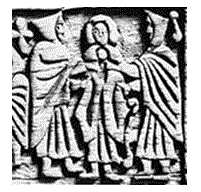 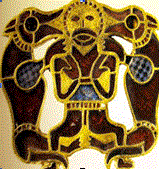 Two people, wearing cloaks, their heads covered with hoods, seem to have grabbed a (here mouthless) third one, a constellation we know from other objects like the Sutton Hoo purse. Maybe, these mysterious beings are trying to pull the victim to the one or other side. If opposing forces, the symbols behind their hoods could tell. Two people, wearing cloaks, their heads covered with hoods, seem to have grabbed a (here mouthless) third one, a constellation we know from other objects like the Sutton Hoo purse. Maybe, these mysterious beings are trying to pull the victim to the one or other side. If opposing forces, the symbols behind their hoods could tell.
Actually, both of them have shown up before, the cross-mark (left) preceding the name Titus may be meant to conjure strength and victory, while the “yew-rune mark”  stands for death and rebirth, here rather resurrection into Valhalla. stands for death and rebirth, here rather resurrection into Valhalla.
Quite obviously the three inserted words (risci, wudu, bita) are not supposed to comment the scene. The explanation for all this can be found in Northern mythology: A hurled twig turns into a spear and kills the victim. Baldur was killed by a mistletoe wand which turned into a "Then Starkathr thrust at the king with the wand and said: 'Now I give thee to Othinn.' Then Starkathr let go the fir bough. The wand became a spear and pierced through the king...."
Here it could be Herh-Os, who flings the fatal rush (risci) at him. It changes into a spear (kenning: wudu) and this weapon bites (Kenning: bita) her chosen warrior. And if we interpret the twig behind the horse as a twig rune we arrive at the 3rd ætt, first rune (3/1), and that is  . .
In order to get from one site to the next Herh-Os changes into a bird and flies from her “mound of harm” to the battle-field. Now she is standing at the grave, the spear that she had flung as a twig firmly in her hand, the shaft ending in a spearhead formed by the rune  . There she – now in her human shape – revives her latest victim with a drink from the chalice. She will take the hero from Midgard to Asgard, to Valhalla, to be precise. . There she – now in her human shape – revives her latest victim with a drink from the chalice. She will take the hero from Midgard to Asgard, to Valhalla, to be precise.
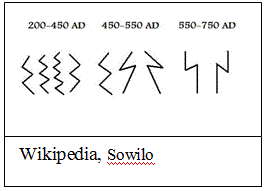 All these episodes point into the direction of Woden / Odin. Herh-Os would have acted at his will bringing harm ( All these episodes point into the direction of Woden / Odin. Herh-Os would have acted at his will bringing harm ( , hagal, hail) about that warrior, and at his will the fighter is chosen for life under the Sun ( , hagal, hail) about that warrior, and at his will the fighter is chosen for life under the Sun ( ) in Valhalla. Actually, ) in Valhalla. Actually,  is the dominating rune of this panel, as is the dominating rune of this panel, as  (hagal, hail) – unpreceded by any charms – only brings death (I-rune (hagal, hail) – unpreceded by any charms – only brings death (I-rune  = is, ice) about. = is, ice) about.
But if we now have a closer look at the 6 cryptographic I-runes we find that the marks used as their substitutes actually are S-runes in shapes the Elder Fuþark had used centuries before. Thus the symbol of death (ice) turns into an emblem of life (sun) in Woden’s Valhalla, this way illustrating the double nature of the god himself.
The first stanza with its  alliteration signals harm, but in the second stanza alliteration signals harm, but in the second stanza  (A)< and (E) alliterate, which effects the turn around. Then, anyway, the 9-rune formula drigiþ swa precedes the final third verse where (A)< and (E) alliterate, which effects the turn around. Then, anyway, the 9-rune formula drigiþ swa precedes the final third verse where  (sigel, Sun) alliterates. Woden’s bright realm in Asgard, has won over Hel, the sphere of the shadows; another image for resurrection from death. Following Simrock and others Odin’s pawned eye stands for the Sun. If so, the rune (sigel, Sun) alliterates. Woden’s bright realm in Asgard, has won over Hel, the sphere of the shadows; another image for resurrection from death. Following Simrock and others Odin’s pawned eye stands for the Sun. If so, the rune  also hints at Woden / Odin, just as the entire panel refers to him.
Following Tacitus’ Interpretatio Romana Woden is the Germanic counterpart of Mercurius, who among other virtues was venerated for his protective power at averting harm. also hints at Woden / Odin, just as the entire panel refers to him.
Following Tacitus’ Interpretatio Romana Woden is the Germanic counterpart of Mercurius, who among other virtues was venerated for his protective power at averting harm.
The Four Panels:
As we have seen the sequence of motifs follows very consequently a certain pattern:
The Front Panel renders with Christ and Mary side by side with Wayland the trinity Caesar knows as Sol, Luna and Vulcanus, god of fire and smithy. The scene relates to Modraniht. The topic may be described as “[Death and] Birth”.
The Left Panel shows Roman twins (sons of Mars or Hercules [!]) in their boyhood, thus at an early stage in life. Romulus, at the end of his life, ascended to replace the Roman god Quirinus. The alliteration on R ( as thematic rune) connects this scene with Þunor/Thor and his Roman counterpart Hercules. The topic may be described as “Youth”. as thematic rune) connects this scene with Þunor/Thor and his Roman counterpart Hercules. The topic may be described as “Youth”.
The Back Panel describes the victory (70 AD) of Titus over the Jerusalem. The later Roman Emperor was eventually deified by the Roman Senate. The initial rune  (T as thematic rune) connects this scene with Tiw/Tyr and his Roman counterpart, the god of warfare, Mars. He (like, perhaps, Tiw), originally, was venerated as a deity of agriculture. The topic can be described as “Prime of Life”. (T as thematic rune) connects this scene with Tiw/Tyr and his Roman counterpart, the god of warfare, Mars. He (like, perhaps, Tiw), originally, was venerated as a deity of agriculture. The topic can be described as “Prime of Life”.
The Right Panel illustrates the heroic death of a warrior brought about by Woden’s Valkyrie. With his resurrection into location of afterlife, Valhalla, death turns into heroic life among the Einherjer. As illustrated by the initial runes  and and  which indirectly refer to Woden / Odin, god of the chosen warriors, the topic may be described as “Death [and Rebirth]”. This can be understood as an image of harvest time which includes the seed for new vegetation. which indirectly refer to Woden / Odin, god of the chosen warriors, the topic may be described as “Death [and Rebirth]”. This can be understood as an image of harvest time which includes the seed for new vegetation.
In short, the two trinities Caesar and Tacitus report must have been known in Anglo-Saxon days, as they seem to form the background of Franks Casket’s pagan scenery. We may just wonder how the Lid fits into this pantheon, and: whether or not Freyr was known and venerated in the context of these trinities.
In short, the two trinitie Caesar and Tacitus report must have been known in Anglo-Saxon days, as they seem to form the background of Franks Casket’s pagan scenery. We may just wonder how the Lid fits into this pantheon, and: whether or not Freyr was known and venerated in the context of these trinities.
The Lid (Æ): Asgard
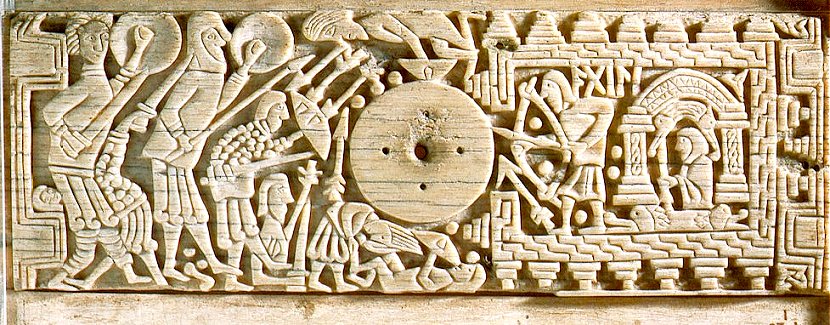
© Trustees of the British Museum
Only the middle-segment of the Lid has survived. Anyway, it is very likely that the missing fragments had been covered with silver fittings which did not continue the central scene, nor did the Lid bear a text on its edges.
The image does not follow any classical pattern either, as it renders pagan Germanic views.
The sequence of panels describes a biography from birth over ride to war on to victory and, eventually, to a heroic death, which qualifies for Valhalla. Thus it does not need much speculation to identify that place right here as Valhalla, Woden’s site at the days of Ragnarök. A horde of warriors – two of them rather giants than men – move toward the fortification on the right, a few others, budging into the opposite direction, seem to combat them. They all are in trouble.
Asgard
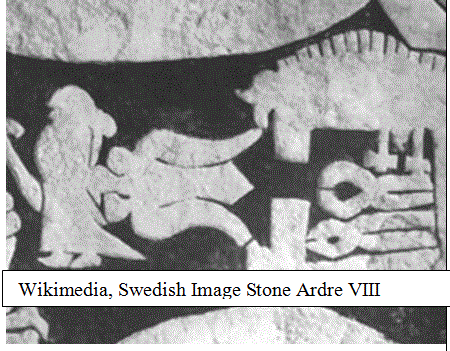 Right of the round segment, which once must have worn a meaningful element (not just a knob), there is a fortified enclosure with a gate, - not a house with a window as often maintained, – rather a horizontal projection. The elements attached to the wall are battlements and can be read as symbols of the 540 gates of Valhalla. The elements which compose the walls may be seen as s-runes [ Right of the round segment, which once must have worn a meaningful element (not just a knob), there is a fortified enclosure with a gate, - not a house with a window as often maintained, – rather a horizontal projection. The elements attached to the wall are battlements and can be read as symbols of the 540 gates of Valhalla. The elements which compose the walls may be seen as s-runes [   significantly 24 or 27], which would turn the site into a realm of a Sun deity. The archer in the door is named Ægil(i). The initial rune significantly 24 or 27], which would turn the site into a realm of a Sun deity. The archer in the door is named Ægil(i). The initial rune  (æsc) refers to the ash-tree and symbolizes “defence”. (æsc) refers to the ash-tree and symbolizes “defence”.
Apart from that, in Norse mythology Yggdrasil is an immense ash in connection to which the nine worlds exist, with Asgard, realm of the Æsir, in its top.
According to this view the arch is Odin’s throne, Hlidskialf, and the double headed animals would stand for his ravens and wolves. From his throne in Valhalla Odin can overlook and overhear all the nine worlds, which constitute the Germanic cosmology. The Casket-Lid, the top of it all, would be the most appropriate spot for that, be it Heaven or be it Asgard. Whether or not he is the person depicted on the throne remains unanswered.
Actually, in Skírnismál, it is Freyr who sits in Hliðskjálf when he looks into Jötunheimr and sees the beautiful giant maiden Gerðr, with whom he instantly falls in love. He asks Skírnir, his servant, to go to Jötunheimr to woo Gerðr for him. Freyr gives Skirnir a steed and his magical sword which fights on its own "if wise be he who wields it". Eventually, Gerðr becomes his wife. This is the casus belli for the giants. Although deprived of his weapon, Freyr defeats the jötunn Beli with an antler. However, lacking his sword, Freyr gets killed by the fire jötunn Surtr during the events of Ragnarök.
If we comprehend nakedness as a kenning for being unarmed we may detect Freyr in one of the two warriors above and below the disc which once may have held the golden emblem of the sun. Since Freyr was seen as the Lord of the Sun this closeness would suit his nature as the Sun is the main object of attack at Ragnarök and will eventually be devoured by the wolf Fenrir (or Skalli), just like Odin himself. The battle depicted here could very well show the fight over the Sun himself. The other bare person – if scenic - may be Freyr’s servant Skirnir, who according to his position would not be better equipped than his master. If emblematic, Freyr could stand for each of the two naked warriors. Due to the lack of perspective and room these two braves are (or just Freyr is) not lying on the ground, - not dead at all. As there is a remarkable difference in body height the bigger one may represent Freyr, the Lord, else it might be the same person at a different state.
The Seasons
From Asgard, the top of Yggdrasil, Freyr rules over the trinity of Sun (Sol), Moon (Luna), and Fire (Vulcanus) as depicted on the front panel, represented there by Christ, Mary and Wayland and simultaneously over the more familiar Germanic trinity of Thunor/Thor, Tiw/Tyr, and Woden/Odin, who correspond to the trinity of Hercules Mars and Mercury in Tacitus’ Roman interpretation.
Considering the – originally – close relation of deities and vegetation we may comprehend the sequence of these panels (front, left, back, right) as the successive chain of the seasons: Winter (winter,), spring (lencten), summer (sumor) and autumn (hærfest).
Interpreting them in this clockwise rotation [like the course of the sun] we understand Caesar’s trinity (Front) as Midwinter introducing the New Year with the Birth of the Sun (geol). In this context Christ as Sol Invictus may be understood as turning point, as the link between Death and Rebirth. At the same time the god of vegetation rules and keeps watch over the three seasons (spring, summer and winter), which according to Tacitus, fill the year of the Germans. Anyway, at the days of our hoard box autumn was known as hærfest. Beda Venerabilis ascribes 3 months to each season, though “commonly only winter and summer were distinguished by the length of their days.” This would explain why
the said 3 Germanic gods stand for 3 seasons with Woden now connected to autumn, while the newcomers, Christ in particular, from then on, fill in for the “depth of winter”, as nothing would fit better to Midwinter and Mōdraniht than the picture of Mother and Child along with the Magi.
On the left panel, dominated by Thunor, the Roman baby-brothers, fed by the wolf, would symbolize Spring, whereas the back panel, ruled by Tiw, depicts with Titus’ victory over the Jews manhood in its prime and thus stands for Summer. The right panel, dominated by Woden and his Einherjer-collecting Valkyries, stands for Hærfest, Autumn, as we now say.

The days of the Week
At a second glance we realize that the days of the week are represented along with these gods from the above trinities: Sun, Moon, Tiw, Woden and Thor. If so, Frigg and Saturn still need to be identified. Saturday (Sæternesdæg) is of Roman origin as it refers to Saturnus, god of agriculture and vegetation. Wayland, who stands for the Roman god Vulcanus, seems to fill in for him.
With Vulcanus in mind we think of “fire” as the link between both of them, but there is no real evidence for Saturn as a fire-deity. He was seen as a god of generation, dissolution, farming, periodic renewal and freedom, - and of plenty and wealth, which is on Wayland’s line. Later traits of the Greek god Kronos were ascribed to him. Kronos learned that he was destined to be overcome by his own sons, just as he had overthrown his father Uranus. Thus he swallowed all his children as soon as they had been born. This maltreatment of children along with plenty and wealth may be the common denominator. Wayland kills Niðud’s sons, when they visit him in secret and fashions goblets from their skulls of which their parents drink. This actually means they imbibe – much like Kronos – their own offspring. Apart from that Saturn / Kronos is said to show features of the Phoenician Moloch to whom parents sacrificed their children by fire. If we now ascribe Saturday to the picture of Wayland we have matched three successive days of the week with the trinity represented on the front panel while the remaining days are rendered on the sides of the casket by the other trinity, composed of the Æsir hiding behind the thematic runes.
Friday (Frigedæg) refers to Frigg, the most prominent female member of the Æsir and spouse of the chief god, Woden / Odin. She is the Germanic counterpart of Venus, after who most Romance languages name this day. And she is the mother of Baldur , who in Norse mythology is seen as the god of light, spring, and justice, as it is said in the Prose Edda: “He is best, and all praise him; he is so fair of feature, and so bright, that light shines from him”. (Gylfaginning) His death, accidentally brought about by his brother Höðr, is both, a great tragedy to the Æsir and a harbinger of Ragnarök. If originally a vegetation god rather than one of the Æsir he dies in order to be reborn. This way he could be identified with the Sun, thus somehow an Interpretatio Germanica of Sol Invictus, as ascribed to Christ by the Magi-picture. Frigg, the powerful Mother-Goddess, the ‘lady’, the ‘dear one’, may compare to Mary, - also in so far as both of them count among the few females playing a leading part in pagan or Christian context. Likewise, her name is the only female person's name that brands a weekday, Friday. She is depicted here under the arch, holding her distaff.

|


 Instead of the Virgin sitting on a throne, holding the child on her lap and he greeting the visitors, there are only their disc-like faces, marked by halos – that of the child cross-shaped. This presentation is similar to that of Sol Invictus ("Unconquered Sun"), who was the official Sun-god of the later Roman Empire and a patron of soldiers.
Instead of the Virgin sitting on a throne, holding the child on her lap and he greeting the visitors, there are only their disc-like faces, marked by halos – that of the child cross-shaped. This presentation is similar to that of Sol Invictus ("Unconquered Sun"), who was the official Sun-god of the later Roman Empire and a patron of soldiers.
 Finally Pope Innocent III (around 1200) allowed the association of Mary and Moon: "Anybody buried in the shade of sin should look up to the moon. After having lost the grace of God, there will be no day, no sun to shine on him, but there is still the moon above the horizon. Let her talk to Mary under whose guidance many find the right way to God."
Finally Pope Innocent III (around 1200) allowed the association of Mary and Moon: "Anybody buried in the shade of sin should look up to the moon. After having lost the grace of God, there will be no day, no sun to shine on him, but there is still the moon above the horizon. Let her talk to Mary under whose guidance many find the right way to God." 
 Either the twins are depicted all alone with the she-wolf or – rather seldom in the ancient world – their retrieval by the shepherd is rendered, but there is no piece known that would show them adored by a gang of armed warriors somewhere in a grove. The roots there seem to function as “tree runes” foretelling the fortune of the warriors and the fate the twins bring about. Ancient pictures would place the baby-brothers under the she-wolf where they are fed, but none would show them as youngsters. Moreover, we have Woden’s two wolves instead of just the lone lupa.
Either the twins are depicted all alone with the she-wolf or – rather seldom in the ancient world – their retrieval by the shepherd is rendered, but there is no piece known that would show them adored by a gang of armed warriors somewhere in a grove. The roots there seem to function as “tree runes” foretelling the fortune of the warriors and the fate the twins bring about. Ancient pictures would place the baby-brothers under the she-wolf where they are fed, but none would show them as youngsters. Moreover, we have Woden’s two wolves instead of just the lone lupa.
 Anyway, it would have been closer to home if the rune master had picked other war helping twin brothers like the legendary Hengist and Horsa, but their names begin with
Anyway, it would have been closer to home if the rune master had picked other war helping twin brothers like the legendary Hengist and Horsa, but their names begin with  The text, framing the picture ends (bottom left corner) with 3 dot-marks. As we ascribe numeric value to such marks they refer to the third rune of the fuþorc, according to the “Runic Poem” ðorn (NE. thorn), which is quite likely the substitute for the pagan Þunor (Donar, Thor). This way the spell (text) based on
The text, framing the picture ends (bottom left corner) with 3 dot-marks. As we ascribe numeric value to such marks they refer to the third rune of the fuþorc, according to the “Runic Poem” ðorn (NE. thorn), which is quite likely the substitute for the pagan Þunor (Donar, Thor). This way the spell (text) based on 

 Herh-Os seems to be the name of the creature sitting here on a mound (harmberg), a Valkyrie most likely. Herh (hearg) means the pagan holy grove; Os identifies the creature dwelling there as a deity. The shape of her head may be that of a cow elk, a species (elk) that is reflected in the rune
Herh-Os seems to be the name of the creature sitting here on a mound (harmberg), a Valkyrie most likely. Herh (hearg) means the pagan holy grove; Os identifies the creature dwelling there as a deity. The shape of her head may be that of a cow elk, a species (elk) that is reflected in the rune 
 Two people, wearing cloaks, their heads covered with hoods, seem to have grabbed a (here mouthless) third one, a constellation we know from other objects like the Sutton Hoo purse. Maybe, these mysterious beings are trying to pull the victim to the one or other side. If opposing forces, the symbols behind their hoods could tell.
Two people, wearing cloaks, their heads covered with hoods, seem to have grabbed a (here mouthless) third one, a constellation we know from other objects like the Sutton Hoo purse. Maybe, these mysterious beings are trying to pull the victim to the one or other side. If opposing forces, the symbols behind their hoods could tell.
 All these episodes point into the direction of
All these episodes point into the direction of 
 Right of the round segment, which once must have worn a meaningful element (not just a knob), there is a fortified enclosure with a gate, - not a house with a window as often maintained, – rather a horizontal projection. The elements attached to the wall are battlements and can be read as symbols of the 540 gates of Valhalla. The elements which compose the walls may be seen as s-runes [
Right of the round segment, which once must have worn a meaningful element (not just a knob), there is a fortified enclosure with a gate, - not a house with a window as often maintained, – rather a horizontal projection. The elements attached to the wall are battlements and can be read as symbols of the 540 gates of Valhalla. The elements which compose the walls may be seen as s-runes [




